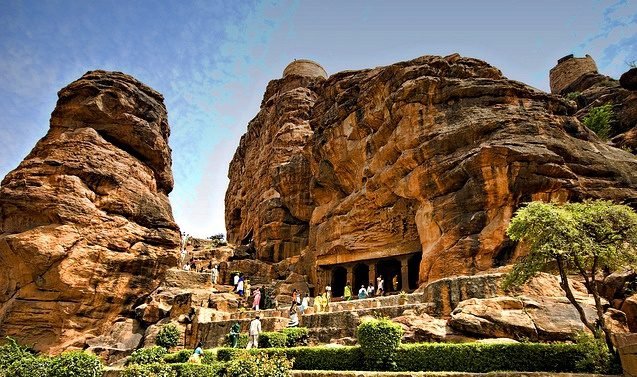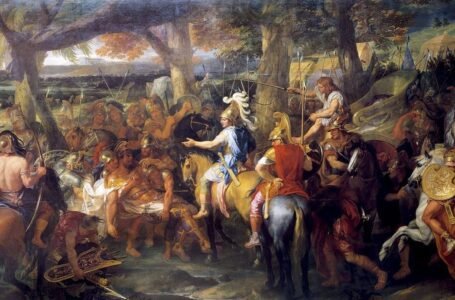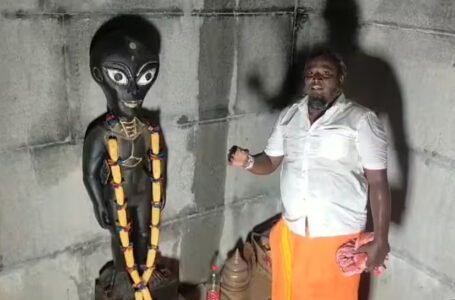Badami Cave Temples: A Stunning Blend of Rock-Cut Architecture and Spiritual Significance

The Badami cave temples, located in Badami, Karnataka, are an exceptional architectural marvel representing a blend of Buddhist, Hindu, and Jain religious traditions. These temples, carved into the hillsides of Badami, stand as early examples of rock-cut architecture in India. Built between the 6th and 8th centuries, the Badami caves have become one of the most significant cultural and architectural sites in the country. The town of Badami, historically known as Vatapi, was the capital of the Chalukya dynasty, which ruled a vast region of southern India during the early medieval period. These caves are a testament to the Chalukya dynasty’s influence, reflecting a sophisticated understanding of religious iconography and architectural design. Today, the Badami cave temples continue to be an important symbol of India’s rich history and the architectural evolution of temple design, influencing later Hindu temples across the region.
History
The Badami cave temples were carved into the soft sandstone cliffs of the town of Badami, which was once known as Vatapi, the capital of the Early Chalukya dynasty. This dynasty ruled from the 6th to the 8th century, and the Badami caves were constructed during this period, marking the beginning of the Chalukya architectural style. These caves are considered some of the earliest rock-cut temples in India, with Cave 3 being the oldest firmly dated Hindu cave temple, dating back to 578 CE.
Badami, situated at the confluence of the Malaprabha and Krishna rivers, was strategically located and became an important cultural and political center during the reign of the Chalukyas. The temples in Badami were part of a larger architectural and religious movement that also saw the creation of other monuments in Aihole and Pattadakal, forming a cradle of temple architecture that would influence later Hindu temples across India.
The four main caves in Badami represent the artistic and architectural innovations of the time. Cave 3, dedicated to Vishnu, is the largest and most intricately designed, while Cave 4, dedicated to Jain Tirthankaras, stands as a symbol of the region’s religious diversity. These caves, with their detailed carvings and inscriptions, provide valuable insights into the religious and cultural milieu of the time. The caves’ art and architecture reflect a combination of northern and southern Indian styles, including the Nagara, Dravida, and Vesara architectural styles, creating a unique fusion that would later shape the architectural development of temples in the Deccan region.
Architecture
The architecture of the Badami cave temples is a remarkable example of rock-cut architecture, with structures carved into the hillsides rather than being built with traditional construction methods. The temples are located on an escarpment of the hill, with each cave designed with a verandah, a main hall, and a sanctum sanctorum. The entrance of each cave features a verandah, supported by intricately carved stone columns and brackets, which lead into a larger hall before reaching the sanctum. This layout is a distinctive feature of the Badami cave temples.
The caves are carved out of soft Badami sandstone, with their design reflecting the architectural styles of the time. Cave 1, the first temple in the series, is 59 feet above ground level, with access via a series of steps. Inside, the cave features a large carving of Shiva as Nataraja, with 18 arms representing different dance poses. This depiction is a key example of the fusion of art and religious symbolism, with the dance gestures representing the cosmic cycle of creation and destruction.
Cave 2 is dedicated primarily to Vishnu and is smaller than Cave 1. It features detailed carvings, including a large relief of Vishnu in his Trivikrama form, stepping over the three worlds. The cave also contains representations of Vishnu’s Varaha and Vamana avatars. The ceiling and walls of the cave are adorned with fresco paintings and geometric patterns, suggesting the use of color in the original design.
Cave 3, the largest and most elaborate, is dedicated to Vishnu and features several major carvings, including Trivikrama, Anantasayana, and Narasimha. The cave’s artwork reflects the fusion of northern and southern Indian architectural styles, with a mix of Nagara, Dravida, and Vesara influences. This cave also features some of the earliest examples of yantra-chakra motifs and colored frescoes, adding to the visual richness of the site.
Cave 4, the smallest of the four, is dedicated to Jainism and features carvings of Jain Tirthankaras, including Mahavira, Parshvanatha, and Bahubali. This cave highlights the religious tolerance of the Chalukya dynasty, with both Hindu and Jain temples existing side by side. The Jain figures are depicted with intricate detail, with Mahavira shown seated on a lion throne and Parshvanatha depicted with a multi-headed cobra hood.
Deities
The Badami cave temples feature a diverse range of deities, representing the religious pluralism of the time. Cave 1, dedicated to Hinduism, showcases various forms of Shiva, including the iconic Nataraja, the dancing Shiva. This depiction symbolizes the cosmic rhythm of creation and destruction. The cave also features carvings of Mahishasura Mardini, where Durga defeats the demon Mahishasura, symbolizing the victory of good over evil.
Cave 2, primarily dedicated to Vishnu, contains large carvings of Vishnu in various forms, including Trivikrama, Varaha, and Vamana. These depictions highlight the importance of Vishnu in the religious landscape of the time, with each avatar representing a different aspect of cosmic order. The reliefs in Cave 2 also include scenes from Hindu texts like the Bhagavata Purana, including the cosmic ocean churning and the birth of Krishna.
Cave 3, while also dedicated to Vishnu, features a mix of Vishnu and Shiva representations, such as Harihara, a fused image of Vishnu and Shiva. This reflects the harmonious coexistence of different religious traditions in the Chalukya kingdom. The cave also features Narasimha, the lion-headed avatar of Vishnu, as well as Trivikrama and Anantasayana, further emphasizing the importance of Vishnu in the region’s religious practices.
Cave 4, dedicated to Jainism, contains carvings of Jain Tirthankaras, including Mahavira, Parshvanatha, and Bahubali. The Tirthankaras are depicted in various poses, with Bahubali shown in a meditative stance surrounded by vines. These carvings reflect the Jain tradition’s emphasis on non-violence, asceticism, and spiritual enlightenment.
Conclusion
The Badami cave temples stand as a testament to the architectural ingenuity and religious diversity of early medieval India. Carved into the sandstone cliffs of Badami, these temples showcase the fusion of different artistic styles, reflecting the cultural and religious richness of the time. The caves’ detailed sculptures and inscriptions provide valuable insights into the religious practices, beliefs, and artistic traditions of the Chalukya dynasty and the surrounding regions. The Badami cave temples continue to be an important cultural and architectural landmark, influencing the development of temple architecture in the Deccan region and beyond. Today, they stand as a symbol of India’s rich cultural heritage, attracting visitors and scholars alike to admire their beauty and historical significance.


